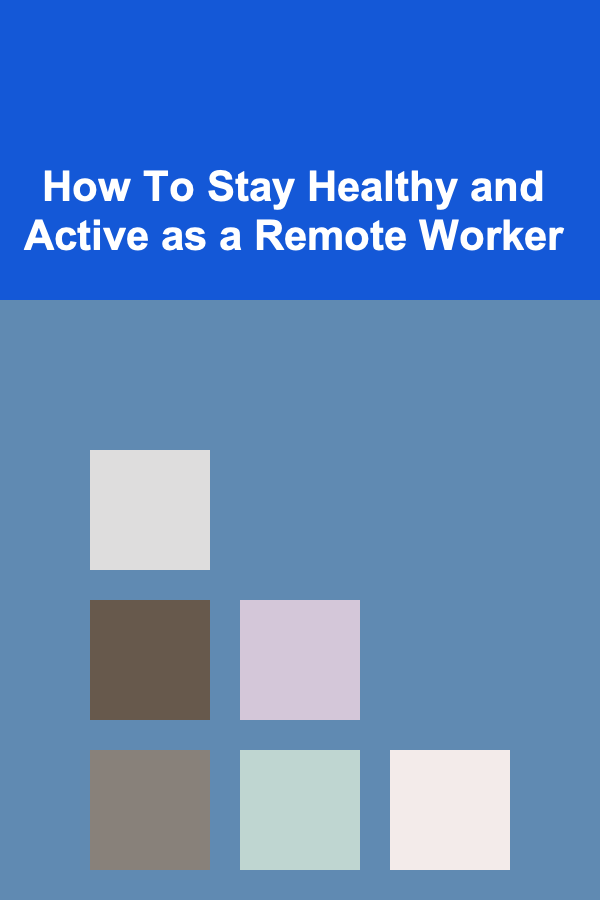
How To Stay Healthy and Active as a Remote Worker
ebook include PDF & Audio bundle (Micro Guide)
$12.99$8.99
Limited Time Offer! Order within the next:

Remote work has become more prevalent in recent years, offering flexibility and comfort to employees. However, it also presents unique challenges when it comes to maintaining physical and mental well-being. Without the structure of an office environment, remote workers can find themselves stuck in sedentary lifestyles, struggling to balance work and personal life, and experiencing negative effects on their health.
In this article, we will explore strategies and tips to help remote workers stay healthy and active. From managing time effectively to incorporating physical activity into your daily routine, these tips will ensure you can thrive in a remote work setting while maintaining your health and productivity.
The Impact of Remote Work on Health
Before diving into strategies for staying healthy and active, it's important to understand the potential health risks that come with remote work.
1.1 Physical Health Risks
Remote work often means sitting for long periods at a desk, which can contribute to a number of physical health problems:
- Sedentary Lifestyle: Sitting for extended periods without regular movement can lead to weight gain, poor posture, and increased risk of cardiovascular diseases, diabetes, and joint pain.
- Poor Ergonomics: Many remote workers don't have access to ergonomic furniture, which can cause discomfort and musculoskeletal problems. Bad posture, improper screen height, or using uncomfortable chairs can result in back pain, neck strain, and repetitive strain injuries (RSI).
- Lack of Exercise: A sedentary lifestyle combined with a lack of regular physical activity can lead to a decrease in fitness levels, flexibility, and strength. This makes it harder to perform day-to-day tasks and could lead to more serious long-term health issues.
1.2 Mental Health Challenges
Remote work can also impact mental health in several ways:
- Isolation: Working from home can lead to feelings of loneliness and social isolation. Without regular interaction with colleagues, remote workers may experience a sense of disconnection, which can contribute to depression and anxiety.
- Work-Life Balance: The blurred boundaries between work and personal life can create stress and burnout. Many remote workers struggle to set clear boundaries, leading to overwork, lack of downtime, and difficulty switching off from job-related stress.
- Lack of Structure: Without the structure of a traditional office environment, some remote workers may struggle to establish routines and prioritize self-care. This can lead to unhealthy habits, such as poor sleep, erratic eating patterns, and irregular physical activity.
While these challenges can be daunting, they are not insurmountable. By implementing specific strategies, remote workers can maintain both physical and mental health while working from home.
Creating a Healthy Workspace
The first step in staying healthy as a remote worker is to create a workspace that supports both your physical and mental well-being. The right environment can help promote productivity, reduce physical strain, and provide a sense of structure.
2.1 Ergonomic Desk Setup
An ergonomic workstation is essential for preventing musculoskeletal issues and ensuring comfort during long hours of work. Here are some tips for creating an ergonomic setup:
- Chair: Invest in a chair that provides proper lumbar support. Your chair should support the natural curve of your spine and allow your feet to rest flat on the ground. If you don't have an ergonomic chair, consider using cushions or lumbar supports to improve comfort.
- Desk Height: Ensure your desk is at an appropriate height so that your arms are at a 90-degree angle when typing. Your wrists should not be strained, and your elbows should remain close to your body.
- Monitor Position: Your computer screen should be at eye level, around 20-30 inches from your eyes. This reduces strain on your neck and eyes and prevents you from hunching forward.
- Keyboard and Mouse: Keep your keyboard and mouse at a comfortable height and distance. If possible, use an external keyboard and mouse rather than relying on a laptop, as this allows for better ergonomics.
2.2 Lighting and Ambiance
The right lighting can reduce eye strain and contribute to a more productive and comfortable work environment. Natural light is ideal, as it improves mood and alertness. Position your desk near a window if possible, or use light sources that mimic natural daylight.
Avoid harsh overhead lights or fluorescent lighting, as these can cause headaches and fatigue. Consider using adjustable task lamps with soft, warm light to reduce glare and shadows.
2.3 Declutter Your Workspace
A cluttered workspace can lead to stress and distraction, negatively affecting productivity. Keep your workspace organized and free of unnecessary items. Use storage solutions like file organizers, shelves, and drawer organizers to keep things tidy. An organized environment can help create a sense of calm and focus, which is important for maintaining mental clarity.
Time Management and Structure
One of the challenges of remote work is the lack of structure. Without clear boundaries between work and personal life, it's easy to lose track of time, overwork, or neglect personal well-being. Setting up a routine and managing time effectively is key to staying healthy.
3.1 Create a Daily Schedule
A structured daily schedule is essential for maintaining a work-life balance and ensuring you stay productive. Here are some tips for creating a healthy routine:
- Set Specific Working Hours: Define a set start and end time for your workday. This will help create a clear boundary between work and personal time and prevent you from working late into the night.
- Prioritize Tasks: Break down your work tasks into manageable chunks and prioritize them based on importance and deadlines. Use productivity methods such as the Pomodoro technique, where you work in focused intervals followed by short breaks, to maintain concentration and prevent burnout.
- Build Breaks into Your Day: Schedule regular breaks throughout your workday to give your mind and body time to recharge. A quick walk, stretching exercises, or even a short meditation session can help alleviate stress and boost productivity.
- End Your Day with a Routine: Establish an end-of-day routine that signals to your brain that work is over. This can include tidying up your workspace, reviewing your accomplishments for the day, and setting goals for tomorrow. This routine helps create a clear mental transition from work to relaxation.
3.2 Avoiding Overwork
Remote workers often struggle with overwork because there's no physical separation between home and office. To avoid burnout, be mindful of how much time you're spending working.
- Set Boundaries: Establish clear boundaries with your colleagues, family, and friends about your availability. Let others know when you're working and when you're off-duty.
- Use Technology Wisely: Turn off notifications during non-working hours to prevent distractions. Consider using time management apps to track your working hours and ensure you're not overextending yourself.
Staying Active and Fit
Staying physically active is crucial for remote workers, especially since working from home can encourage a sedentary lifestyle. Regular movement is essential for maintaining cardiovascular health, flexibility, and strength, as well as improving mental clarity and focus.
4.1 Incorporate Physical Activity into Your Routine
Physical activity doesn't have to be a chore. There are several simple ways to stay active throughout the day:
- Morning Exercise Routine: Start your day with a short workout, such as yoga, stretching, or a quick bodyweight routine. This helps wake up your body, increases energy, and sets a positive tone for the day.
- Use Breaks for Movement: Take advantage of your breaks to get moving. Whether it's a brisk walk around the block, a short workout, or some light stretching, incorporating movement into your day helps prevent the negative effects of prolonged sitting.
- Desk Exercises: If you're working at a desk for long hours, try doing desk exercises to keep your muscles engaged. Stand up and do leg raises, calf raises, or simple stretches every 30 minutes to maintain circulation and reduce muscle tension.
4.2 Set Up a Home Gym
If you have the space and resources, setting up a home gym can make it easier to stay consistent with your fitness goals. You don't need a lot of equipment to get started -- dumbbells, resistance bands, and a yoga mat can be enough for a full-body workout. There are plenty of online resources, including free YouTube channels, to guide you through at-home workouts.
4.3 Join Virtual Fitness Communities
To stay motivated and accountable, consider joining a virtual fitness community or taking part in online fitness challenges. These communities can provide support, encouragement, and a sense of camaraderie that can help you stay on track with your fitness goals.
Prioritizing Mental Health
Maintaining mental health is just as important as physical health, especially when working remotely. The isolation, lack of social interaction, and stress of managing work and personal life can take a toll on your well-being.
5.1 Practice Mindfulness and Meditation
Mindfulness and meditation can help reduce stress, increase focus, and improve overall mental health. Set aside a few minutes each day to practice deep breathing or meditation. There are many guided meditation apps and YouTube videos available to help you get started.
5.2 Stay Connected with Others
It's important to maintain social connections, even if you're working remotely. Schedule regular video calls or virtual meetups with family, friends, or coworkers. Engaging in social activities, even if virtual, can reduce feelings of isolation and provide emotional support.
5.3 Take Time Off
Don't forget to take time off from work to relax and recharge. Use your vacation days, weekends, or personal time to disconnect from work and focus on activities that bring you joy and relaxation. This helps prevent burnout and promotes long-term well-being.
Conclusion
Staying healthy and active as a remote worker requires intentional effort and planning. By creating an ergonomic workspace, managing your time effectively, staying physically active, and prioritizing your mental health, you can overcome the challenges of remote work and thrive in a flexible, healthy environment.
It's important to remember that your health should always come first. Take the time to establish routines and habits that support both your physical and mental well-being, and don't be afraid to ask for support when needed. With these strategies, remote work can be both a fulfilling and sustainable career choice.
Reading More From Our Other Websites
- [Personal Investment 101] Make Money by Creating and Selling AI-Powered Products
- [Organization Tip 101] How to Organize Your Email Inbox for Clarity
- [Home Storage Solution 101] How to Create an Elegant Jewelry Storage System for Your Home
- [Home Renovating 101] How to Make Your Home More Pet-Friendly Through Renovations
- [Home Budget Decorating 101] How to Decorate Your Home on a Small Budget
- [Organization Tip 101] How to Create a Comprehensive Pantry Inventory List
- [Home Budget Decorating 101] How to Decorate Your Home Using Free and Cheap Printables
- [Organization Tip 101] How to Create a Checklist for Your Yard Sale Preparation
- [Home Pet Care 101] Traveling with Your Pet: A Comprehensive Checklist
- [Home Maintenance 101] How to Regularly Inspect and Maintain Your Home's Electrical Wiring

How to Market Your Home Music Lessons to Local Students
Read More
How to Safeguard Your Home During Vacations
Read More
How to Set Financial Goals and Achieve Them Consistently
Read More
Why Organizing Your Outdoor Space Can Enhance Entertaining
Read More
How to Write Engaging Blog Posts and Articles
Read More
How To Understand the Psychology of Consumer Behavior
Read MoreOther Products

How to Market Your Home Music Lessons to Local Students
Read More
How to Safeguard Your Home During Vacations
Read More
How to Set Financial Goals and Achieve Them Consistently
Read More
Why Organizing Your Outdoor Space Can Enhance Entertaining
Read More
How to Write Engaging Blog Posts and Articles
Read More